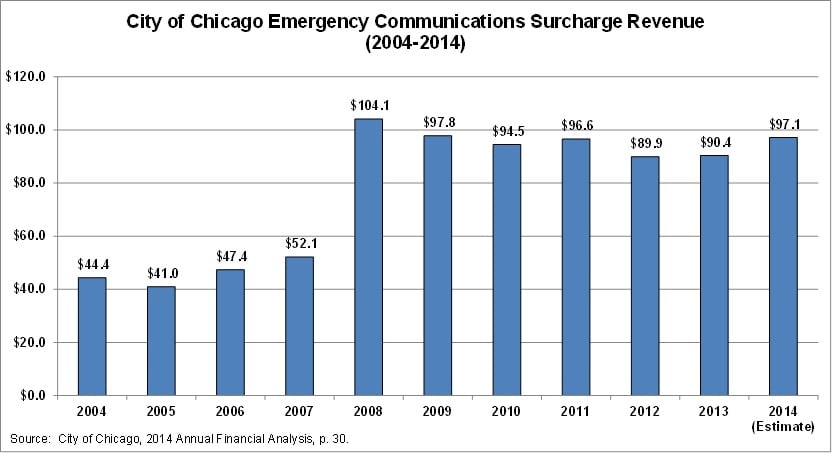August 20, 2014
Public Act 98-0641, the City of Chicago’s pension reform bill, originally called for an increase in property taxes to help fund the Municipal Employees’ Annuity and Benefit Fund (MEABF) and the Laborers’ and Retirement Board Employees’ Annuity and Benefit Fund (LABF) of Chicago. However, in response to a lack of support for the property tax provision of the bill, it was revised to remove the property tax language. As a result, the City of Chicago had to find an alternative source of revenue to provide much needed additional funding.
The alternative revenue source was the 911 emergency communications surcharge. However, because state law governs the rate local governments can impose on telecommunication subscribers, the City of Chicago sought legislative action in the bill reauthorizing the surcharge for wireless communication subscribers and allowing an increase to the rate.
On July 30, 2014, the Chicago City Council approved an ordinance amending the Municipal Code of Chicago to increase the emergency communications surcharge paid by subscribers of telecommunication services within the City of Chicago. The chart below displays the increase of the surcharge for telecommunication subscribers and individuals who purchase prepaid phone services in the City of Chicago between 2008 and 2014. Prior to 2012, individuals purchasing pre-paid phone services were charged a flat monthly fee of $2.50. In 2012 the state law changed the flat fee of $2.50 to a rate of 7.0% of the prepaid phone purchase. Prior to 2008 the emergency communication surcharge was $1.25 for telecommunication subscribers and individuals purchasing prepaid phone services.[1]
In 2013 the City of Chicago’s expenditures to operate the 911 communication center and emergency preparedness functions of the city were approximately $140.0 million. However, the emergency communications surcharge revenues only generated approximately $90.4 million, creating a shortfall of approximately $50.0 million.[2]
The shortfall in 911 surcharge revenues to fully fund the 911 communications center and emergency preparedness functions required the City of Chicago to subsidize those expenses with corporate fund resources. By implementing the increased 911 surcharge the City was able to reduce the amount of corporate fund revenue used for the 911 center and allow corporate fund resources to be used to fund the increased pension contributions required under P.A. 98-0641.
The graph below displays the City of Chicago emergency communications surcharge revenue from 2004 to 2013 and the year-end estimate for 2014. The 2014 year-end estimate includes an additional $10.0 million in revenue that will be generated during the last quarter of the fiscal year. Because the landline and wireless line rates will go into effect on September 1, 2014 and the prepaid rate will go into effect on October 1, 2014, it is projected that almost $40.0 million in additional revenue will be collected in FY2015.[3] The graph below clearly depicts the 2008 rate increase, followed by a steady decline in revenues for the following five years. The decline in revenue is partly due to the fact that as cell phones have become more popular, residents have begun disconnecting their landlines instead of maintaining both a landline and a cellular phone line.[4]

Although emergency telecommunication revenues are expected to increase in the coming years due to the increased surcharge, the City of Chicago has recognized that additional revenue sources will be needed to help fund its fiscal obligations moving forward. Public Act 98-0641 requires significant annual increases to the City of Chicago’s contribution to the Municipal and Laborers’ Funds through 2021, when it will begin making actuarially-required contributions to reach 90% funded by the end of 2055.


